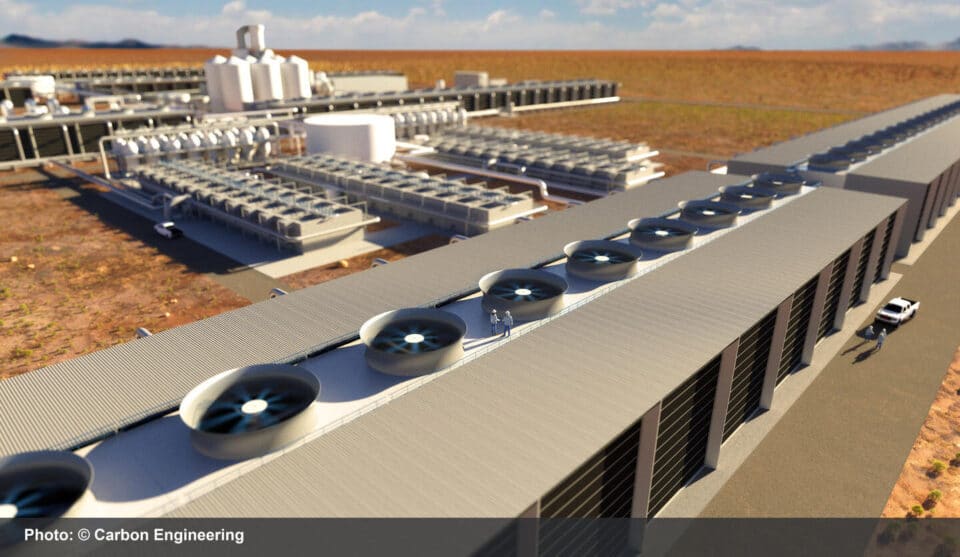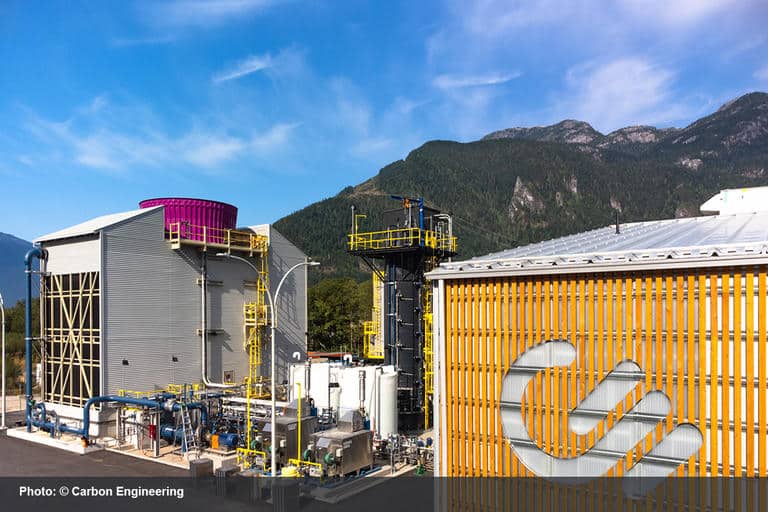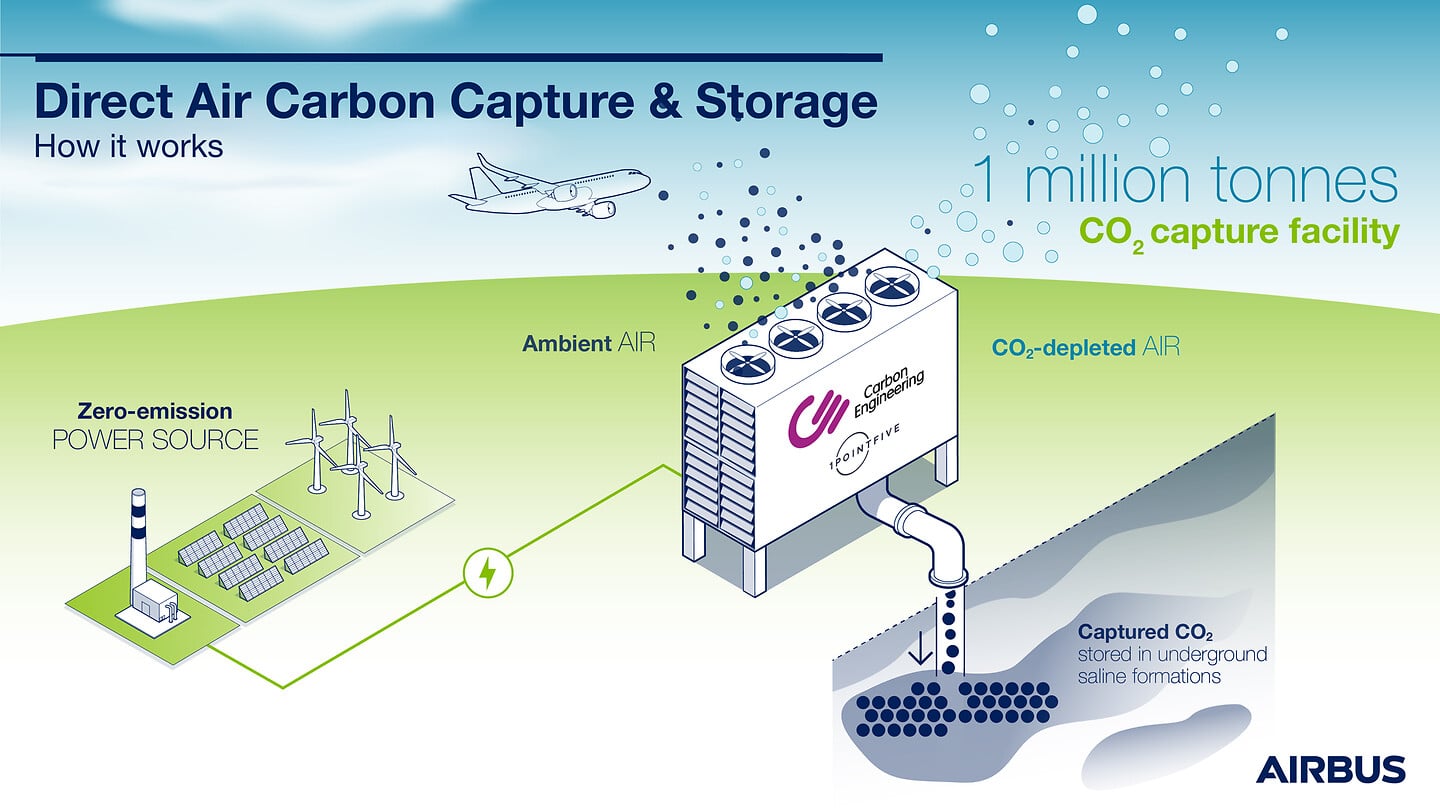Aerospace
Airbus and Seven airlines have signed letters of intent to look into aviation carbon removal systems.
Seven airlines have joined the airbus company’s effort to reduce the amount of carbon in the environment. The initiative will lower the carbon footprint and utilise the leftover energy for various uses. #Airbus #CO2 #carbon-remove

Letters of Intent (LoI) have been signed by Airbus and several significant airlines, including Air Canada, Air France-KLM, easyJet, International Airlines Group, LATAM Airlines Group, Lufthansa Group, and Virgin Atlantic, to investigate the possibility of a future supply of carbon removal credits from direct air carbon capture technology.
A high-potential technique called Direct Air Carbon Capture and Storage (DACCS) filters and removes CO2 emissions directly from the air using powerful fans. The CO2 is safely and permanently stored in geologic reservoirs after being taken out of the atmosphere. A direct air carbon capture and storage solution would enable the aviation industry to recover the same amount of emissions from its activities directly from the atmosphere since the sector is unable to capture CO2 emissions emitted into the sky at source.
- DACCS: how it works
What many people might consider science fiction is quickly becoming reality. A number of sectors could be able to reach their net-zero carbon emissions goals with the aid of Direct Air Carbon Capture and Storage (DACCS), which captures CO2 caused by human activity straight from the atmosphere. It is emerging as a possible complementary solution to sustainable aviation fuel and hydrogen for hard-to-abate industries like aviation.
This is a direct air capture facility through which hundreds of tonnes of carbon are being drawn in from the air. Here, in the year 2030 and in the heart of the Lone Star state, this spectacular creation is now a key bastion in the fight against climate change and the world’s transition to a net-zero energy system.
- Used to create fuels like Power-to-Liquid through a complementary process called AIR TO FUELSTM.
A direct air capture facility, or DAC for short, functions like a massive, extremely effective tree by sucking air from the environment and removing any CO2 that is present in it. There will probably be dozens of them all around the world in 2030. But moving forward to the present, this technology is still in its infancy.
To remedy this, Carbon Engineering is working. At its pilot facility in Squamish, Canada, the Canadian company developed a direct air capture technology, and it is now aiming for widespread adoption. These facilities are being developed on a megaton scale both in the US and other countries by 1PointFive, Carbon Engineering’s licenced US partner. The Permian Basin’s DAC project, which is scheduled to start operating in 2024, will eventually be able to capture up to a million tonnes of CO2 annually. This essentially equates to the labour or capacity for absorption of 40 million trees.
The pure CO2 that has been gathered can then be either stored underground or used to create fuels like Power-to-Liquid through a complementary process called AIR TO FUELSTM. In the former, sometimes referred to as carbon storage or sequestration, CO2 is injected into salt deposits more than a kilometre below the surface of the planet. Therefore, CO2 is securely and permanently deposited underground.
-
Introducing scalable, affordable carbon removal technologies for aircraft.
The aviation sector adopted the long-term climate goal of having net-zero carbon emissions by 2050 in October 2021. To accomplish this, a variety of decarbonization strategies, including technological advancements in aircraft design, new fuels like hydrogen and SAF, efficiency gains in airport operations and air traffic management, and market-based measures, have all been identified. However, they won’t be enough on their own to bring aviation’s CO2 emissions down to the necessary levels.
The Intergovernmental Panel on Climate Change (IPCC) claims that extracting CO2 from the atmosphere will also be required if the world is to reach net zero emissions by 2050. Additionally, direct air capture is necessary because hard-to-reduce industry like aviation cannot remove their pollutants at the source.
To provide carbon reductions via direct air capture technology to the aviation industry, Airbus has teamed with 1PointFive. In fact, as part of an initial offtake, Airbus has pre-purchased 100,000 tonnes of carbon reductions annually from 1PointFive for four years, totaling 400,000 tonnes.
In order to promote direct air capture as a crucial method of reaching the industry’s net-zero target, several airlines have expressed interest in working with Airbus in this area. Partnerships like these, which bring together important stakeholders from both inside and outside the industry, will be crucial to bringing climate-neutral air travel ever closer to reality as the aviation sector continues to improve its course towards net zero.

Aerospace
Which is bigger 777x or 787 aircraft ?

The 777X is a new series of the Boeing 777 family and is designed to be larger and more efficient than its predecessor. It features two variants: the 777-8 and the 777-9, being the larger of the two.
The Boeing 777X emerges as the larger sibling within the Boeing family, representing a significant leap forward in both size and efficiency. Comprising two variants, the 777-8 and the 777-9, the latter takes the crown as the larger of the two. With its expansive fuselage and impressive wingspan, the 777X is tailored for long-range journeys and boasts a substantial passenger capacity.
On the other hand, the Boeing 787, affectionately known as the Dreamliner, occupies a niche in the market as a smaller yet formidable aircraft designed for medium to long-range flights. Its distinguishing feature lies in its composite fuselage, a technological marvel that renders it lighter and more fuel-efficient compared to conventional aluminum counterparts. The Boeing 777X is larger than the Boeing 787 aircraft.
When it comes to passenger capacity, the 777-9 reigns supreme, typically accommodating a sizeable contingent of 400-425 passengers in its standard configuration. In contrast, the 787, with its more modest dimensions, typically carries between 240-290 passengers, depending on the variant and layout.
One of the remarkable innovations introduced with the 777X is its folding wingtips, a feature designed to address the logistical challenges of accommodating such a large aircraft in conventional airport gates. These folding wingtips enable the 777X to retract its wings, allowing it to fit into gates designed for smaller aircraft while still reaping the benefits of an extended wingspan during flight, thereby enhancing fuel efficiency and operational flexibility
Aerospace
China Secures Production Certificate for Mass Production of Pilotless eVTOL Aircraft

The first passenger-carrying pilotless electric vertical takeoff and landing (eVTOL) aircraft in the world, the EH216-S, has received the Production Certificate for its eVTOL aircraft from the Civil Aviation Administration of China (CAAC).
This is a significant milestone for EHang Holdings Limited, the leading UAM technology platform company in the world. This outstanding accomplishment is another big step towards mass manufacturing for the eVTOL aircraft and the ensuing commercial operations, building on the ground-breaking acquisition of the Type Certificate and the Standard Airworthiness Certificate for the EH216-S.
The PC is a crucial certificate that the aircraft maker receives from the CAAC, the country’s aviation authority. By obtaining this certificate, EHang has demonstrated that it has set up a quality management system for mass production that satisfies the airworthiness regulation standards set forth by the CAAC, and the company has been given permission to continue producing mass quantities.
It is also a strong guarantee of the calibre of the goods made by EHang. Raw materials, supplier management, manufacturing organisation, production quality control, aircraft pre-delivery test, after-sales repair and maintenance, etc. are all included in the mass production quality management system for the EH216-S.
To ensure that every aircraft and its components that roll off the production line strictly adhere to the approved type design and safety requirements, the system sets clear guidelines and documentation for every step in the production procedure. This ensures comprehensive traceability and safety control.
Aerospace
Four Airbus A380 Superjumbos lined up to be scrapped

In a strategic move aimed at reclaiming valuable resources from the iconic Airbus A380 aircraft, VAS Aero Services and Dr. Peters Group have announced a significant collaboration.
This partnership marks a milestone in aviation logistics and aftermarket services, with four of these colossal planes slated for teardown and redistribution of used serviceable material (USM).
The venture between VAS Aero Services, renowned for its expertise in aircraft dismantlement, and Dr. Peters Group, a prominent Germany-based investment fund management firm, underscores a commitment to sustainable aviation practices. This isn’t their first foray into scrapping A380s; their successful partnership has already seen the dismantlement of these aircraft, making them pioneers in this niche.
Under the agreement, the latest consignment brings the tally to eight A380s entrusted to VAS by Dr. Peters Group. Managing Director Christian Mailly of Dr. Peters Group emphasized the trust placed in VAS, citing their unparalleled capabilities in dismantlement and aftermarket sales network. It’s a strategic move in response to the growing demand for quality USM parts, particularly with the resurgence in reliance on the A380.
Notably, the teardown process will be carried out at various locations, optimizing the positioning of harvested parts to cater to different markets. While some parts will be positioned in Europe to support operators in the region and the Middle East, others will remain in the Asia-Pacific region. This meticulous strategy ensures efficient access to spare parts, benefiting MROs and airlines across these markets.
The decision to retire these A380s comes at a time when operators are reassessing fleet strategies amidst evolving market dynamics. Despite initial plans for quick retirement due to the emergence of more fuel-efficient alternatives, factors such as a rebound in long-haul demand and delays in new widebody deliveries have prompted operators to reconsider. The A380, with its unique capacity and capabilities, presents a practical solution for short-term capacity management.





























